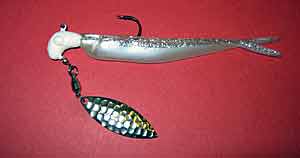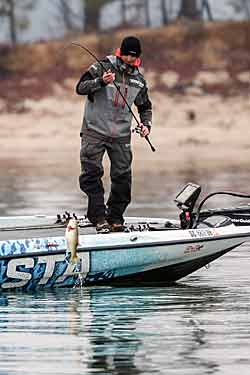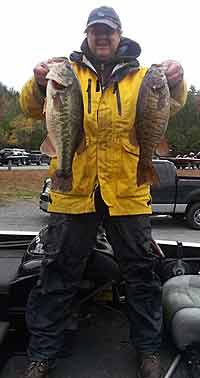
The Bassmaster Classic has always been a proving ground and coming-out party for new lures. Many lures, such as the swimming worm New Jersey angler Michael Iaconelli fished to win the 2003 Bassmaster Classic on the Louisiana Delta and enjoy a brief blast of fame before fizzing out. A select few go on to tackle immortality. And then there are the regional lures that enjoy some popularity before returning to their roots. Such was the case for the underspin after the 2004 Classic, thanks to Aaron Martens’ second-place finish.
Martens, a California-bred angler who now calls Alabama home, spent all three competition days fishing abutments under the Buster Boyd Bridge, which spans the midpoint of Lake Wylie, the Catawba River impoundment on the North and South Carolina border. He tipped his underspin with a Zoom fluke and swam past key abutments, a stone throw from the launch, to catch 36 pounds and 6 ounces. That accomplishment generated some national interest for underspins.
Blakemore, the company that has used TV personality and tournament angler Jimmy Houston to market its Road Runner underspins to panfish anglers for many years, teamed with Martens to develop one for bass anglers. A few other companies followed suit. But the popularity was short-lived, drowned by the splash made by the fourth-place finisher, Dean Rojas. He caught his bass on a hollow-bodied frog, showing the angling public that amphibian imitators also work on lakes devoid of grass. Frog fishing across the country skyrocketed after that, and tackle manufacturers capitalized on it.
Even though the underspin’s national popularity never took off, the lure continued to be a favorite with anglers who fish deeper reservoirs of Georgia, South Carolina, and North Carolina. The lure is effective at catching suspended spotted bass and largemouth chasing blueback herring, the nomadic baitfish that cause headaches for anglers accustomed to casting at targets. And that was just the scenario that would put the underspin back under the spotlight.

A mid-February date and record-setting low temperatures made fishing tough for many at the 2015 Bassmaster Classic on Lake Hartwell, an impoundment on the Georgia-South Carolina line. Casey Ashley, who hails from nearby Donald, S.C., capitalized on the underspin’s power as a potent fish-catcher. It even pushed aside jigs, which he thought would win the tournament. He spent most of the three-day event slowly dragging his underspin across the bottom in 30 to 40 feet of water.
The 3/8-ounce lure was hand-poured by his father, featured a 4/0 hook, and was tipped with a pearl white Zoom Super Fluke Junior. It caught the 50 pounds and 1 ounce of bass he weighed, which was good enough for first place and $300,000. But he wasn’t the only one who fished an underspin. Virginia angler Jacob Powroznik used one to finish fifth, and it was rigged and ready on the decks of more than half of the competitors’ boats.
In today’s Web-connected world, regional lures rarely stay in their birthplace. Often anglers take them to other parts of the country, where they adapt them to their needs and then catch boatloads of bass. That’s precisely what tournament angler and bass guide Ed Cowan has done with the underspin, far from its Southeastern home range.
Cowan has built an impressive fishing resume that includes numerous wins on the state and regional level, two B.A.S.S. Nation Championship wins, and two Bassmaster Classic appearances. Today he fishes tournaments and guides on Lake Wallenpaupack and other small lakes around his home in the Pocono Mountains of Pennsylvania.
He first encountered underspins — which also are called horsehead jigs, fish-head spins, and blade runners — about ten years ago. At that time, he and many other Northeastern anglers were getting waxed in early spring tournaments by one individual angler. And the rumor around the launch ramp was that he was throwing an underspin. So as tournament anglers do, Cowan started fishing them and hasn’t stopped.
Cowan throws underspins whenever the water is 50 degrees or colder, which means early spring and late fall in his neck of the woods. He’s caught bass on them in water that was in the 30s when ice remained or was just forming. He said an underspin is a search bait, and they cover more water than other lure choices for those water temperatures: Silver Buddies, hair jigs, swimbaits, spoons, and tight-wobbling crankbaits. Underspins catch numbers of bass and big ones, too, including an 8-pounder that one of his buddies landed right after ice-out.
“If you are out there, and the surface temperature is 39 degrees, and it’s the third week of November,” Cowan said, “you are fishing for big fish.” Conditions and bass change as spring moves closer to summer. He has caught bass by buzzing underspins over submerged weeds, but their effectiveness falls as water temperatures climb and bass move to their summer haunts. That’s when he puts down his underspin and picks up lures that he can power fish through shallow water. With its exposed hook, underspins do not do well in heavy cover. Like all lures, underspins are just one tool. You need to select the correct one for the job at hand.
Cowan fishes underspins in the same places he fishes a jerkbait. “It’s the go-to bait when the jerkbait bite falters,” he said. That means he’s focusing on 3 to 10 feet of water. “There are some places in the Northeast where you can catch [bass] real deep, such as Lake George [in New York],” he said. “But for most of our fishing, we don’t catch them deeper than the weeds grow.”
They usually start petering out in about 20 feet of water. In the northern portion of the country, fall, winter, and early spring spots can vary. In natural lakes, it might be a rocky flat that tapers to a point that disappears into deep water. It might be a hump or a big eddy if you are fishing a river. In the rare impoundment, such as Connecticut’s Candlewood Lake, it might be a channel that leads from the main lake into a protected, south-facing bay. They all are places where smallmouth and largemouth can congregate as they move to spawn areas or deep water winter haunts, depending on the time of year. They all also have rock. There is no better cover for protecting lethargic cold-water bass from current, absorbing and releasing warmth, or providing a steady diet of crawfish.

Regardless of where he fishes an underspin, he retrieves them the same way. “I throw them out, let them sink to the bottom, and slow roll them back in like a spinnerbait,” Cowan said. The straightforward retrieve is productive and easy to master, especially for his clients who may have more fishing interest than experience.
Like Ashley’s father, Cowan pours his underspins only because he can’t find them locally. His favorite is the 1/8-ounce size, which sports a 3/0 Gamakatsu hook and tight-spinning No. 3 willow leaf blade. He said that Colorado and Indiana style blades spin too wide and hit the body. When he fishes deep — 20 to 25 feet of water — he’ll jump up to a 3/8-ounce version.
An underspin is a compact lure that is perfect for using on a spinning rod. But he prefers a casting rod that has a slow action and light power, along with a quality reel with a smooth drag, to protect the 8- or 10-pound test fluorocarbon he uses most often. When he moves deeper, he spools up with braided line tipped with a fluorocarbon leader. Its lack of stretch allows him to solidly set the hook at the end of a long cast.
With its flashy blade, underspins mimic baitfish, whether shad, shiners, or perch. Cowan threads one of two soft-plastic lures on the underspin’s hook to complete the representation. The first is a Keitech 4-inch Swing Impact grub. Its boot tail kicks strong when pulled through the water. The second is a 4-inch Lunker City Fin-S Fish. Its shape closely resembles a baitfish, but it lacks an action tail. Regardless of which style, it will be in a perch or alewife pattern, which matches the predominant forage in the waters he fishes.
The underspin is another fish-catching option for Cowan and, for now, one that few bass outside the Southeast have seen. “It’s a [cold-water] niche bait,” he said. “It just happens to be one that not many anglers are throwing.” It remains to be seen how long that will last, especially after Ashley’s recent Classic win. Other lures have received a similar setup. Some were launched to greater heights, while others sank back into obscurity.
Remember the Do-Nothing Worm Jack Chancellor used to win the 1985 Bassmaster Classic on the Arkansas River? Chances are slim that you do and even worse that you have one in your tackle box. It’s just another example of a lure passed through the sport. How about the Slug-Go? Cowan knows a little something about that lure. He helped push it onto the national stage. He used a 4-inch bubble gum Slug-Go and a tube to win the 1991 B.A.S.S. Nation Championship at Smith Mountain Lake in Virginia. The Slug-Go’s inventor, Herb Reed, finished second. That wasn’t long after the lure was created. “There have been all kinds of trends in fishing over the years,” Cowan said. “The only thing that never fell off is the jig-and-pig.”
What the future holds for the underspin remains to be seen. Maybe going from second to first place in the Bassmaster Classic will encourage more anglers to try it and uncover more uses. But if it doesn’t, that’s most likely okay with Cowan. He’ll keep on enjoying the niche he found for it.

